Related Research Articles

The Last Laugh is a 1924 German silent film directed by German director F. W. Murnau from a screenplay written by Carl Mayer. The film stars Emil Jannings and Maly Delschaft.

Italian neorealism, also known as the Golden Age, was a national film movement characterized by stories set amongst the poor and the working class. They are filmed on location, frequently with non-professional actors. They primarily address the difficult economic and moral conditions of post-World War II Italy, representing changes in the Italian psyche and conditions of everyday life, including poverty, oppression, injustice and desperation.
Film style refers to recognizable cinematic techniques used by filmmakers to create specific value in their work. These techniques can include all aspects of film language, including: sound design, mise-en-scène, dialogue, cinematography, editing, or direction.

Friedrich Wilhelm Murnau was a German film director, producer and screenwriter. He is regarded as one of cinema's most influential filmmakers for his work in the silent era.

Expressionism is a modernist movement, initially in poetry and painting, originating in Northern Europe around the beginning of the 20th century. Its typical trait is to present the world solely from a subjective perspective, distorting it radically for emotional effect in order to evoke moods or ideas. Expressionist artists have sought to express the meaning of emotional experience rather than physical reality.

The New Wave, also called the French New Wave, is a French art film movement that emerged in the late 1950s. The movement was characterized by its rejection of traditional filmmaking conventions in favor of experimentation and a spirit of iconoclasm. New Wave filmmakers explored new approaches to editing, visual style, and narrative, as well as engagement with the social and political upheavals of the era, often making use of irony or exploring existential themes. The New Wave is often considered one of the most influential movements in the history of cinema.

Carl Theodor Dreyer, commonly known as Carl Th. Dreyer, was a Danish film director and screenwriter. Widely considered one of the greatest filmmakers of all time, his movies are noted for emotional austerity and slow, stately pacing, frequent themes of social intolerance, the inseparability of fate and death, and the power of evil in earthly life.

German expressionist cinema was a part of several related creative movements in Germany in the early 20th century that reached a peak in Berlin during the 1920s. These developments were part of a larger Expressionist movement in north and central European culture in fields such as architecture, dance, painting, sculpture and cinema.
Poetic realism was a film movement in France of the 1930s. More a tendency than a movement, poetic realism is not strongly unified like Soviet montage or French Impressionism but were individuals who created this lyrical style. Its leading filmmakers were Pierre Chenal, Jean Vigo, Julien Duvivier, Marcel Carné, and, perhaps the movement's most significant director, Jean Renoir. Renoir made a wide variety of films some influenced by the leftist Popular Front group and even a lyrical short feature film. Frequent stars of these films were Jean Gabin, Michel Simon, Simone Signoret, and Michèle Morgan.
Narrative film, fictional film or fiction film is a motion picture that tells a fictional or fictionalized story, event or narrative. Commercial narrative films with running times of over an hour are often referred to as feature films, or feature-length films. The earliest narrative films, around the turn of the 20th century, were essentially filmed stage plays and for the first three or four decades these commercial productions drew heavily upon the centuries-old theatrical tradition.

Classical Hollywood cinema is a term used in film criticism to describe both a narrative and visual style of filmmaking that first developed in the 1910s to 1920s during the later years of the silent film era. It then became characteristic of American cinema during the Golden Age of Hollywood, between roughly 1927 and 1960. It eventually became the most powerful and pervasive style of filmmaking worldwide.

David Jay Bordwell was an American film theorist and film historian. After receiving his PhD from the University of Iowa in 1973, he wrote more than fifteen volumes on the subject of cinema including Narration in the Fiction Film (1985), Ozu and the Poetics of Cinema (1988), Making Meaning (1989), and On the History of Film Style (1997).

Carl Mayer was an Austrian screenwriter who wrote or co-wrote the screenplays to The Cabinet of Dr. Caligari (1920), The Haunted Castle (1921), Der Letzte Mann (1924), Tartuffe (1926), Sunrise: A Song of Two Humans (1927), and 4 Devils (1928), most of them being films directed by F. W. Murnau. Mayer was a fundamental figure in the dramatic and narrative establishment of both German expressionist cinema and Kammerspielfilm.

Artists in the Big Top: Perplexed is a 1968 West German film written and directed by Alexander Kluge. The film is made in a collage style, featuring newsreels and quotations from philosophers alongside the story of a failing circus whose owner, Leni, must decide whether her dream of a new kind of circus is too optimistic. The film is a symbolic representation of Kluge's own frustrations in trying to help stimulate the New German Cinema movement.
Kristin Thompson is an American film theorist and author whose research interests include the close formal analysis of films, the history of film styles, and "quality television," a genre akin to art film. She wrote two scholarly books in the 1980s which used an analytical technique called neoformalism. As well, she has co-authored two widely used film studies textbooks with her husband David Bordwell.
A chamber play is a play of usually three acts which can be performed with a small cast and practically no sets or costumes in a small space. The form became popular in the early 20th century, with leading exponents being Max Reinhardt and August Strindberg. The first cinema adaptation was Kammerspielfilm in the 1920s, and the format was later adapted for cinema by Ingmar Bergman and Carl Theodor Dreyer.

Le Giornate del cinema muto is an annual festival of silent film held in October in Pordenone, northern Italy. It is the first, largest and most important international festival dedicated to silent film and also is present in the list of the top 50 unmissable film festivals in the world according to Variety. The Pordenone Silent Film Festival is a non-profit association, whose president is Livio Jacob. The director from 1997 until 2015 was David Robinson. In 2016, Jay Weissberg became director. Other members of the festival board are Paolo Cherchi Usai, Lorenzo Codelli, Piero Colussi, Luciano De Giusti, Carlo Montanaro, Piera Patat.
An auteur is an artist with a distinctive approach, usually a film director whose filmmaking control is so unbounded and personal that the director is likened to the "author" of the film, thus manifesting the director's unique style or thematic focus. As an unnamed value, auteurism originated in French film criticism of the late 1940s, and derives from the critical approach of André Bazin and Alexandre Astruc, whereas American critic Andrew Sarris in 1962 called it auteur theory. Yet the concept first appeared in French in 1955 when director François Truffaut termed it policy of the authors, and interpreted the films of some directors, like Alfred Hitchcock, as a body revealing recurring themes and preoccupations.

The Cry is a 1964 Czechoslovak drama film directed by Jaromil Jireš. It was entered into the 1964 Cannes Film Festival. It is often described as the first film of the Czechoslovak New Wave, a movement known for its dark humor, use of non-professional actors, and "art-cinema realism". The film's events are ambiguous, leaving it to the viewer to determine whether the telling is objective or from a character's point of view.
New Year's Eve is a 1924 German silent Kammerspielfilm directed by Lupu Pick and written by Carl Mayer. It was filmed in 1923 and premiered in Berlin on 4 January 1924. The film is known to be one of the earliest examples of a kammerspielfilm and was innovative in its extensive use of "entfesselte Kamera", using tracking and gliding techniques as opposed to keeping the camera stationary. Like Pick's previous films, New Year's Eve does not use intertitles.
References
- ↑ Parkinson (1995, 60).
- ↑ Where to begin with F.W. Murnau|BFI
- ↑ Bordwell, David, and Kristin Thompson , ed. Film History. 3rd. New York: McGraw-Hill, 2010. 95. Print.
- ↑ The Wrong House: The Architecture of Alfred Hitchcock - Steven Jacobs - Google Books (pgs.16-17)
- ↑ Carl Dreyer's "Michael" -Digitalization and the Rediscovery of a classic Kammerspiel-film|Kosmorama
- ↑ Observations on film art: Murnau before NOSFERATU
- ↑ SYLVESTER|Il Cinema Ritrovato Festival